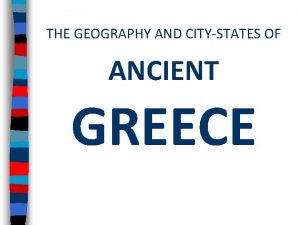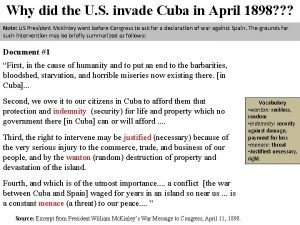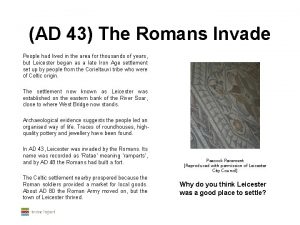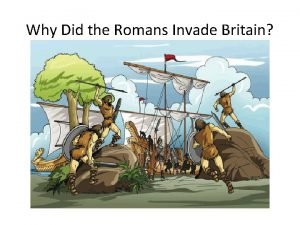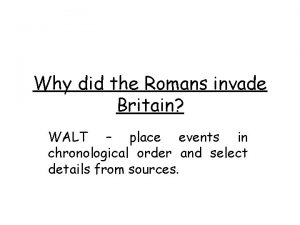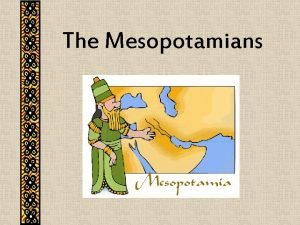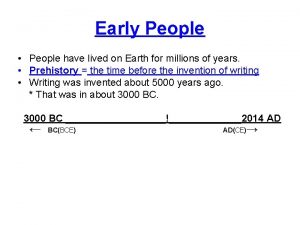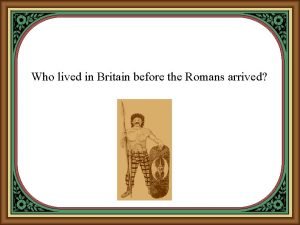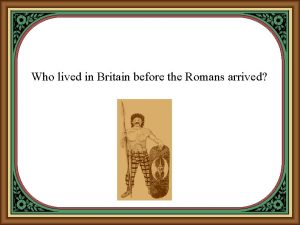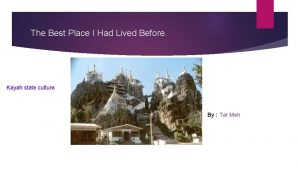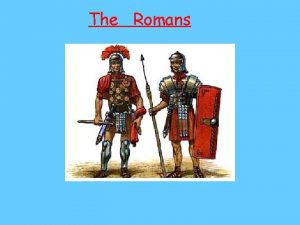AD 43 The Romans Invade People had lived






















- Slides: 22

(AD 43) The Romans Invade People had lived in the area for thousands of years, but Leicester began as a late Iron Age settlement set up by people from the Corieltauvi tribe who were of Celtic origin. The settlement now known as Leicester was established on the eastern bank of the River Soar, close to where West Bridge now stands. Archaeological evidence suggests the people led an organised way of life. Traces of roundhouses, highquality pottery and jewellery have been found. In AD 43, Leicester was invaded by the Romans. Its name was recorded as ‘Ratae’ meaning ‘ramparts’, and by AD 48 the Romans had built a fort. The Celtic settlement nearby prospered because the Roman soldiers provided a market for local goods. About AD 80 the Roman Army moved on, but the town of Leicester thrived. Peacock Pavement [Reproduced with permission of Leicester City Council] Why do you think Leicester was a good place to settle?

(2 nd Century) The Romans Make Leicester Home The streets of Roman Leicester (Ratae) were changed to a grid pattern, with a central space for a market (called a forum). The forum was lined with shops and had a building similar to a town hall – known as a basilica. Many houses were rebuilt in stone with tiled roofs. The Romans also dug drains under the streets. In front St. Nicholas’s Church stands Jewry Wall, the only upstanding remains of the public baths. Arches formed the entrance to the bath complex, built around AD 150. It is one of the largest remaining pieces of Roman masonry in Britain. People entered the baths through the arches after exercising in the gym (palaestra), now lying beneath St. Nicholas’s Church. The remains of the Roman baths were discovered in 1936 when, by coincidence, a new swimming baths was being built. The excavation of the Jewry Wall baths in the late 1930 s [Reproduced with permission of Leicester City Council] Was the Roman invasion a good or bad thing for the people of Leicester?

(3 rd Century) Roman Leicester Thrives Roman Leicester prospered, suburbs grew up outside the walls and villas were built. Excavated coins show that there was a real money economy. Leicester was at the hub of the Roman road network, reflecting its high status. Its public buildings – baths, macellum (market) and temples – also showed its importance. Leicester was the civitas (favoured provincial community) capital of Corieltauvi (a tribe of people living in Britain before the Roman conquest). However, the tribes of what are now southern Scotland northern England had never been fully pacified by the Romans, and there were violent outbreaks. In an effort to subdue Britain, a plan to split the province was thought up by Emperor Septimius Severus. This plan was put into place in AD 211 – the southern province was named Britannia Superior (Upper Britain) with its capital at Londinium (London), and the northern province called Britannia Inferior (Lower Britain), with its capital at Eboracum (York). Artists impression of Roman Leicester [Reproduced with permission of Leicester University. Visions of Ancient Leicester: Reconstructing Life in the Roman and Medieval Town from the Archaeology by Matthew Morris, Richard Buckley, Mike Codd, July 2011] Were the tribes right to fight Roman rule?

(4 th Century) The Romans Leave Leicester Outside Leicester at least 11 settlements are thought to have existed: Mancetter, Tripontium, Market Harborough, Medbourne, Skeffington, Great Casterton, Thistleton, Kirby Bellars, Goadby Marwood and Barrow/Quorn. Roman Leicester reached a peak in the early 4 th century then began to decline. Roman civilization slowly broke down and the Anglo-Saxons started to move into the area. The last Roman soldiers left Britain around AD 407 and Roman towns fell into ruin; Leicester was probably abandoned. Nevertheless, fieldwork undertaken in the area shows that a large proportion of sites in and around Leicester occupied in the 4 th century also produced Anglo-Saxon material. This suggests that there was more continuity from Roman occupation to Saxon than previously thought. Visions of Ancient Leicester: Reconstructing Life in the Roman and Medieval Town from the Archaeology by Matthew Morris, Richard Buckley, Mike Codd, July 2011 [Reproduced with permission of Leicester University] What evidence do you think the artist used to create the image above?

(AD 410) Saxon Leicester As the last Roman soldiers left Britain in AD 410, the Anglo-Saxons, arrived in ships across the North Sea. They settled in Mercia, Northumberland, East Anglia and Wessex. Some Anglo-Saxons built wooden houses inside the walls of Roman towns. In Leicester, Saxon brooches from the AD 400 s and 500 s have been found in the area now known as Highcross, showing that they settled there. Also, cemeteries and timber halls dating from that period have been found across Leicestershire, suggesting that town sites were important in early Saxon times. The Romans called the Anglo-Saxons ‘barbarians’. Whilst some tribes traded with the Romans, many fought them. The Anglo-Saxons were farmers who lived in villages rather than cities. Most people in Roman Britain were Christians, but the Anglo-Saxons worshipped gods and goddesses. Their beliefs were similar to the Celts who lived in Britain before the Romans invaded. Visions of Ancient Leicester: Reconstructing Life in the Roman and Medieval Town from the Archaeology by Matthew Morris, Richard Buckley, Mike Codd, July 2011 [Reproduced with permission of Leicester University] Does this artist give the impression that Anglo-Saxon life was barbaric? Why do you think some people thought they were?

(c. AD 500 -50) Glen Parva Lady In 1866, at Rye Hill Close, about a mile north-west of Glen Parva, to the south of Leicester, workmen were digging for gravel. About 2 ft below the ground they exposed the remains of a Saxon woman who died around AD 500 -50. The woman had been buried with jewellery, fragments of an ivory ring, a glass beaker and two bone plates (probably from a knife handle). The ‘Glen Parva Lady’ (as she is called) helps us understand how the Anglo-Saxons lived in Leicestershire during the 6 th century. Due to her early date, evident high status, the distance of the burial from any known church sites and the lack of religious objects, it is likely that she was a pagan. Her belongings demonstrate that the early Saxon period was far from being a ‘dark age’. The Glen Parva Lady is now on display in the Jewry Wall Museum in Leicester. Glen Parva Lady [Reproduced with permission of Leicester City Council] What does the Glen Parva discovery tell us about Anglo. Saxon life?

(7 th Century) From Paganism to Christianity During the early 7 th century, most men, women and children in Leicester helped on farms and families lived in small communes. Iron tools, knives and swords were made, along with wooden bowls, furniture, clay pottery, leather shoes and jewellery. As well as Anglo-Saxon occupation within the Roman walls around the River Soar, there is also evidence of a settlement outside the south gate, beneath De Montfort University. The Anglo-Saxons were Pagans. They were superstitious, believing in lucky charms, potions and rhymes to protect themselves from evil spirits. From the late 6 th century, missionaries were sent by the Pope to convert them to Christianity. By the late 7 th century, town life started to revive and Leicester was given a bishop. Monasteries were built where monks and nuns studied, prayed and worked. The monasteries were the only schools in Anglo-Saxon England. Visions of Ancient Leicester: Reconstructing Life in the Roman and Medieval Town from the Archaeology by Matthew Morris, Richard Buckley, Mike Codd, July 2011 [ Reproduced with permission of Leicester University] Do you think it was good for all the people of Leicester to have a bishop?

(8 th Century) Offa, King of Mercia Offa was King of Mercia from AD 757 -96. Mercia, in which Leicester was located, was the strongest kingdom in Anglo-Saxon England. In the early years of his reign, Offa gained control of tribes (such as the Hwicce and the Magonsæte) across the middle of England. He became the most powerful English king. Offa came into conflict with the Church, particularly with the Archbishop of Canterbury. He persuaded Pope Adrian I to divide the archdiocese of Canterbury in two, creating a new archdiocese of Lichfield. Offa issued England’s first penny coins, in silver, known as ‘Offa’s pennies’. Along the Welsh border, Offa built an earth wall and ditch for defence, called Offa’s Dyke. About 80 miles of it remains today. Coins issued in the name of Cynethryth, wife of king Offa of Mercia (AD 757 -96 [Image © The Trustees of the British Museum] What would you have liked or disliked about living in Leicester under Offa’s rule?

(9 th Century) The Vikings and Danelaw Vikings from Denmark started raiding in the early 9 th century. They sped down the River Soar to capture Leicester, partly destroying the ancient Roman city walls. By AD 877, England was divided between the Saxon held south, and the Viking controlled north and east of England (known as ‘Danelaw’). Leicester was one of five boroughs of the Danelaw until it was recaptured by Lady Aetheflaed in AD 918. The Saxon Bishop of Leicester fled to safety, leaving some churches to be destroyed and Christian rites trampled. Leicester continued its importance under Danish rule. It even had its own mint. St. Nicholas’s Church was built in the 9 th century from Roman forum material. Although short lived, Danelaw left an everlasting mark on Leicestershire. Many place names linked to the Danish invasion. St Nicholas Church [Reproduced with permission of JCF Ltd] Did Leicester suffer or benefit under Danish rule?

(10 th Century) The Woman Warrior Lady Aethelflaed, described as 'our greatest woman general’, was born around AD 864. She was the eldest daughter of Alfred the Great, King of the Anglo-Saxon kingdom of Wessex, and his Queen, Ealhswith. Aethelflaed captured Derby from the Vikings and defeated them at Leicester. She received an agreement from the citizens of York to take the city but died suddenly at Tamworth in AD 918 before the campaign was completed. Aethelflaed was buried beside her husband at St. Peter's Church (now St. Oswald's Priory) in Gloucester alongside the bones of St. Oswald, a former Christian king of Northumbria. Her tombstone is now displayed in Gloucester City Museum and a statue of her can be found in Jewry Wall Museum, Leicester. A statue to Aethelflaed can also be found in the Guildhall, Leicester. By 918, the English recaptured Leicester from the Danes. Statue of Aethelflaed (Guildhall, Leicester) [Reproduced with permission of Leicester City Council] What privileges and challenges do you think Aethelflaed faced in her life?

(11 th Century) The Norman Conquest was the invasion and occupation of England by an army of Norman, Breton and French soldiers led by Duke William II of Normandy, later William the Conqueror. It is believed the name ‘Leicester’ is derived from ‘castra’ (camp) of the ‘Ligore’, meaning dwellers on the 'River Legro' (now the River Soar). In the early 10 th century it was recorded as ‘Ligeraceaster’ (‘the town of the Ligor people’). The Domesday Book later recorded it as ‘Ledecestre’. By the time of the Norman Conquest, Leicester was a place of some importance with 322 houses and six churches. Suburbs started to grow and records suggest a population of 2, 000. Although Leicester was referred to as a 'civitas' (city), it lost that status during the 11 th century. For the next 800 years, Leicester – one of the most important places in Britain in terms of wealth, trade and religion – was known as a borough or town. The Castle Mound (Motte) - The mound you can see today is about 10 metres high but would have been much higher; about 5 metres of it was removed in 1840 to make the top large enough for a bowling green. [Image : © Historic England] Is Leicester as important now as it was at this time? Why?

(11 th Century) Leicester Castle Following the Norman Conquest there was a period of relative peace and stability. A major abbey was built in meadows north of Leicester and three friaries constructed within the walls. At this time there were revolts against Norman rule. Hugh de Grentmesnil, the first Norman overloard of Leicester, established a castle in Leicester in the late AD 1060 s. The castle had a mound of earth (motte) with a large enclosure below it (bailey). It was strategically positioned overlooking the river (see previous slide). As well as the castle buildings, the area enclosed by the bailey would have had a large number of timber buildings including St. Mary de Castro Church. The Second Earl, Robert le Bossu, built the Great Hall in about 1150. This is probably the oldest surviving aisled and bay-divided timber hall in Britain. It still retains some of its timber arcade posts. Goddard's painting of the interior of the Great Hall in 1821 The image above was painted nearly 900 years after the hall was built. Are paintings reliable sources of evidence?

(12 th Century) St. Mary de Castro In the 1100 s and 1200 s, Leicester experienced a development boom. St. Mary de Castro (‘of the Castle’) Church was originally built as the chapel of Leicester Castle by Henry, Earl of Leicester, in 1107. It was about 40 m long with no tower, spire or glass. About 70 years later it was damaged when the castle was attacked. During repairs it was made longer, and this is how it is today. Early in the 12 th century, the wooden castle, built by the Normans within the town walls, was rebuilt in stone. Following a revolt in 1173, in which the Third Earl, Robert Blanchmains was a leading conspirator rebelling against the king, Leicester was captured by Henry II. Henry ordered the destruction of the castle and burnt down part of the town. However, Leicester soon recovered from this disaster. St Mary de Castro Church 2012 [Reproduced with permission of JCF Ltd] Is it important to protect the built heritage in Leicester? Why?

(13 th Century) Greyfriars By the 1300 s the population of Leicester, although reduced by the Black Death, stood at 4, 000. Simon de Montfort, Earl of Leicester, married Henry III's widowed sister. He took the kingship and ruled from 1264‑ 65. On Simon de Montfort's death at the Battle of Evesham, Leicester passed to the Earls (later the Dukes) of Lancaster, including Henry Bolingbroke who seized the throne from Richard II and became king in 1399. From the 13 th century there were friars in Leicester. Friars were like monks but instead of withdrawing from the world they went out to preach. Franciscan friars were called ‘Greyfriars’ because of the colour they wore. Their name lives on in Greyfriars Street, now famous for the car park where King Richard III’s remains were found. Artists impression of Greyfriars showing the complex to the left and St. Martin’s Church to the right. Visions of Ancient Leicester: Reconstructing Life in the Roman and Medieval Town from the Archaeology by Matthew Morris, Richard Buckley, Mike Codd, July 2011 [Reproduced with permission of Leicester University] What influence did the Greyfriars have on life in Leicester?

(14 th Century) Leicester’s Guilds As the medieval period progressed the guild system became important. It was used by the townsmen in Leicester to promote their common interests, and to progress their business and political ends. There were a number of guilds in the town. The most influential were probably the Merchant Guild in the 12 th and 13 th centuries, and the Corpus Christi Guild in the 15 th century. Leicester’s Guildhall began with the Great Hall, built around 1350 for the meetings of the Corpus Christi Guild. It included accommodation for chantry priests (who sang masses for the members of the guild in their chapel at St. Martin’s Church) and no doubt kitchens and service buildings or rooms. The Great Hall still stands in Leicester today. The Guildhall, 2015 The tower of Leicester Cathedral can also be seen in the background [Reproduced with permission of JCF Ltd] Were the guilds good or bad for trade?

(15 th Century) Richard III The summer of 1485 saw the culmination of the long struggle between branches of the English Royal House who had been disputing the Crown since the death of Edward III in 1377. The harshest disputes took place in the three decades leading up to 1485 (the Wars of the Roses). Richard III, the last of the Plantagenet monarchs, stayed in Leicester before the Battle of Bosworth on 22 August 1485. Richard was killed in battle and his body was brought back to Leicester and buried in the Franciscan friary. Henry Tudor became king. Newarke Gateway (c. 1410) survives in Leicester today. It is located at the western end of Newarke Street. The building is a medieval gateway added to Leicester Castle by the Third Earl of Leicester. Wygston’s House (c. 1490) is the oldest house in Leicester and stands on the High Street close to the meeting houses of what were two medieval guilds, Corpus Christi and St. George. The house may have belonged to Roger Wygston, a member of a rich and important Leicester family. Richard III body was found in the remains of the friary under a car park in 2012. [Reproduced with permission of JCF Ltd] What did the archaeologists learn about Richard III from this discovery?

(16 th Century) The Tudors The Tudor period began when Henry VII defeated Richard III at the Battle of Bosworth in 1485. In the 16 th Century as part of great religious change, Henry VIII closed Leicester Abbey, the friaries, and the hospitals of St. Leonard and St. John. The religious guilds were also dissolved (closed) in 1547. Leicester Guildhall passed into private hands and in due course was purchased by the Corporation of Leicester for £ 25 15 s 4 d. In 1588 the Guildhall was used for a feast to celebrate the defeat of the Armada. The mayor entertained the Earl of Huntingdon, his brother, Walter Hastings, the High Sheriff Thomas Skeffington and many other important people. The guildhall was decorated for the occasion. For many years, the banquet – known as the ‘venison feast’ – was an annual event. The Lord Mayor’s Parlour, Guildhall, Leicester - shown above, dates from 1563 [Reproduced with permission of Leicester City Council] What influence did the Tudors have on Leicester?

(17 th Century) English Civil War Leicester sat on the fence but later supported the Parliamentarians during the English Civil War. In 1645, forces of King Charles I laid siege to the town. The Royalist Army was made up of 5, 500 men. Inside Leicester there were only 2, 000 defenders. Traitors left the town at night revealing weak spots in the walls. The Royalists aimed their cannon at these spots. The defenders tried to plug the gaps with sacks of wool but the Royalist infantry attacked. Many lives were lost and Leicester surrendered. Skeffington House, now Newarke Houses Museum, was damaged during the siege. Newarke Gateway became known as ‘the Magazine’ because it was used to store arms during this period. The victory was short lived as Cromwell defeated the King at the Battle of Naseby a few days later. The Newarke Gateway (the Magazine) [Reproduced with permission of Leicester City Council] What can you find out about this famous siege? Who do you think was right and wrong?

(18 th Century) Industrial Leicester In the late 18 th century Leicester was transformed by the Industrial Revolution. By 1700, Leicester’s knitting industry had developed out of its wool trade. By 1796, the shirt trade in Leicester had begun. Originally stocking making was carried out in homes. As factories took over, steam engines turned the skyline into a sea of smoking chimneys. The Soar Canal was completed in 1794. This provided a cheap way to transport coal and iron to Leicester and allowed an engineering industry to grow up. Canal and rail transport enabled goods made in Leicester to be transported across the globe. Leicester became a wealthy city, one of the ‘workshops of the world’. Much of the city was rebuilt and old buildings swept away. Westbridge [Reproduced with permission of Leicester City Council] Was transport important to the development of Leicester?

(19 th Century) Growing Prosperity With employment available in commerce, the building trades, hosiery, textiles, footwear and engineering, people from across Britain made Leicester their home. From 1861 to 1901 Leicester’s population increased from 68, 000 to 212, 000. When the Municipal Reform Act of 1835 was passed, the first elected Corporation of Leicester was voted in. The new council included local tradespeople and amenities improved. In 1821 Leicester obtained gas street lighting, by 1830, most of the streets were paved, and in 1836, Leicester got its own police force. With prosperity came the start of the modern travel industry. In 1841 Thomas Cook organised a train excursion from Leicester to Loughborough. The Clock Tower, built in 1868, features four statues of famous Leicester figures at its base. It was constructed to control growing amounts of traffic and had a ‘one way round’ system. It is one of Britain’s first roundabouts. The Clock Tower [Reproduced with permission of Leicester City Council] What do you think were the advantages and disadvantages of living in Leicester during this time?

(20 th Century) Two World Wars and Social Change The Great War (1914 -8) and the Second World War (193945) had marked social and economic impact on Leicester's range of industries meant it was better placed than many cities to weather the economic challenges of the 1920 s and 1930 s. By that time too, incoming eastern European Jewish communities, fleeing persecution, brought prosperity through their international business links. In 1928, the Suffragette movement helped gain women the right to vote. A Leicester woman, Alice Hawkins, who spent her working life as a shoe machinist in Leicester, was at the forefront of this movement. During the Second World War, Leicester made footwear and clothing for the troops. Corah’s hosiery works alone produced 17. 5 million pairs of socks. After the War, new communities came to Leicester from Eastern Europe, the Caribbean and the Indian subcontinent. In the years since, the city has welcomed many more new communities, including from war-torn regions of the world. Local men signing up at the Magazine for Fist World War [Reproduced with permission of Leicester City Council] What impact did the wars of this century have on local industry?

(21 st Century) Modern Leicester continues to grow and develop. The population is around 330, 000. Whilst its manufacturing industry has declined, Leicester’s economy is now based on a very strong and enterprising small business community. Owing to the diversity of its population, the city has a reputation for innovation and creativity. Leicester is one of the best-connected cities in the country. It is at the heart of the national road network and East Midlands Airport is only 25 minutes away. The city centre has a vibrant retail sector, strengthened by the development of the £ 350 m Highcross shopping centre. The city appointed its first directly elected mayor, Sir Peter Soulsby, in 2011. In 2012, Leicester was at the centre of much media frenzy when the bones of King Richard III were found buried under a car park in the Greyfriars area. High Cross, Leicester [Reproduced with permission of Leicester City Council] What do you think is the most significant building in Leicester’s history and why?
 Romans invade greece
Romans invade greece Why did romans invade britain
Why did romans invade britain Why did romans invade britain
Why did romans invade britain Once upon a time hansel
Once upon a time hansel Mattie silver had lived under
Mattie silver had lived under English short stories with moral
English short stories with moral Finish my breakfast
Finish my breakfast I have taken my breakfast
I have taken my breakfast Chapter 31 section 4 aggressors invade nations
Chapter 31 section 4 aggressors invade nations Why did the us invade cuba
Why did the us invade cuba Rmivuxg
Rmivuxg Aggressors invade nations
Aggressors invade nations Red martians invade venus
Red martians invade venus Raging martians invaded venus using x-ray guns
Raging martians invaded venus using x-ray guns Why did the us invade cuba
Why did the us invade cuba Longest wavelength electromagnetic spectrum
Longest wavelength electromagnetic spectrum Aggressors invade nations
Aggressors invade nations Chapter 31 section 4 aggressors invade nations
Chapter 31 section 4 aggressors invade nations Red martians invade venus using x ray guns
Red martians invade venus using x ray guns We have pacified some thousands of the islanders
We have pacified some thousands of the islanders Andreas vesalius
Andreas vesalius Diễn thế sinh thái là
Diễn thế sinh thái là Vẽ hình chiếu vuông góc của vật thể sau
Vẽ hình chiếu vuông góc của vật thể sau
